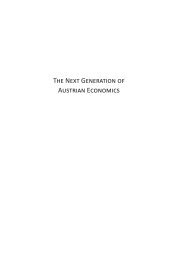capitalist_and_entrepreneur_klein
capitalist_and_entrepreneur_klein
capitalist_and_entrepreneur_klein
Create successful ePaper yourself
Turn your PDF publications into a flip-book with our unique Google optimized e-Paper software.
ix<br />
theory of the firm, preferring to focus on business-cycle theory, welfare<br />
economics, political economy, comparative economic systems, <strong>and</strong> other<br />
areas. Until recently, the theory of the firm was an almost completely<br />
neglected area in Austrian economics, but over the last decade, a small Austrian<br />
literature on the firm has emerged. While these works cover a wide<br />
variety of theoretical <strong>and</strong> applied topics, their authors share the view that<br />
Austrian insights have something to offer students of firm organization.<br />
e essays in this volume, originally published between 1996 <strong>and</strong><br />
2009, deal with firms, contracts, <strong>entrepreneur</strong>s—in short, with the economics<br />
<strong>and</strong> management of organizations <strong>and</strong> markets. Chapter 1, “Economic<br />
Calculation <strong>and</strong> the Limits of Organization,” first presented in<br />
Williamson’s Institutional Economics Workshop in 1994, shows how<br />
the economic calculation problem identified by Mises (1920) helps underst<strong>and</strong><br />
the limits to firm size, an argument first offered by Rothbard<br />
(1962). It also offers a summary of the socialist calculation debate that has<br />
worked well, for me, in the classroom. Along with chapter 2, “Entrepreneurship<br />
<strong>and</strong> Corporate Governance,” it offers an outline of an Austrian<br />
theory of the firm, based on the Misesian concept of <strong>entrepreneur</strong>ship<br />
<strong>and</strong> the role of monetary calculation as the <strong>entrepreneur</strong>’s essential tool.<br />
“Entrepreneurship <strong>and</strong> Corporate Governance” also suggests four areas<br />
for Austrian research in corporate governance: firms as investments, internal<br />
capital markets, comparative corporate governance, <strong>and</strong> financiers as<br />
<strong>entrepreneur</strong>s. Chapter 3, “Do Entrepreneurs Make Predictable Mistakes”<br />
(with S<strong>and</strong>ra Klein), applies this framework to the problem of corporate<br />
divestitures.<br />
Chapter 4, “e Entrepreneurial Organization of Heterogeneous Capital”<br />
(with Kirsten Foss, Nicolai Foss, <strong>and</strong> S<strong>and</strong>ra Klein), shows how<br />
Austrian capital theory provides further insight into the firm’s existence,<br />
boundaries, <strong>and</strong> internal organization. e Austrian idea that resources<br />
are heterogeneous, that capital goods have what Lachmann (1956) called<br />
“multiple specificities,” is hardly surprising to specialists in strategic management,<br />
a literature that abounds with notions of unique “resources,”<br />
“competencies,” “capabilities,” “assets,” <strong>and</strong> the like. But modern theories<br />
of economic organization are not built on a unified theory of capital<br />
heterogeneity, simply invoking ad hoc specificities when necessary. e<br />
Misesian concept of the capital-owning <strong>entrepreneur</strong>, seeking to arrange<br />
his unique resources into value-adding combinations, helps illuminate








